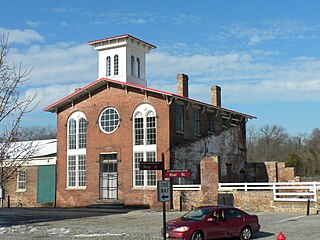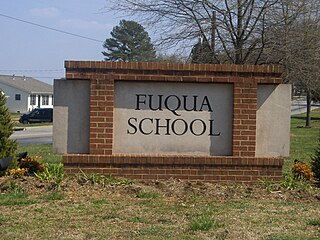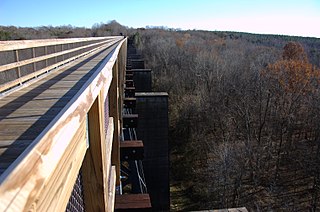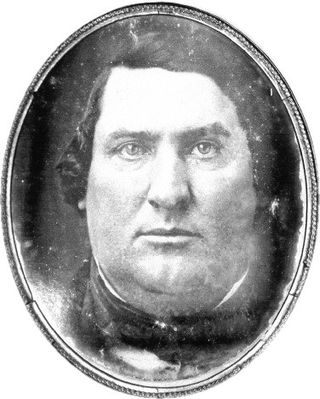
Petersburg is an independent city in the Commonwealth of Virginia in the United States. As of the 2020 census, the population was 33,458 with a majority black American. The Bureau of Economic Analysis combines Petersburg with Dinwiddie County for statistical purposes. The city is 21 miles (34 km) south of the commonwealth (state) capital city of Richmond.

Pamplin City is a town in Appomattox and Prince Edward counties in the U.S. state of Virginia. The population was 138 at the 2020 United States census.

Farmville is a town in Prince Edward and Cumberland counties in the Commonwealth of Virginia. The population was 7,473 at the 2020 census. It is the county seat of Prince Edward County.
Davis v. County School Board of Prince Edward County was one of the five cases combined into Brown v. Board of Education, the famous case in which the U.S. Supreme Court, in 1954, officially overturned racial segregation in U.S. public schools. The Davis case was the only such case to be initiated by a student protest. The case challenged segregation in Prince Edward County, Virginia.
Massive resistance was a strategy declared by U.S. senator Harry F. Byrd Sr. of Virginia and his son Harry Jr.'s brother-in-law, James M. Thomson, who represented Alexandria in the Virginia General Assembly, to get the state's white politicians to pass laws and policies to prevent public school desegregation, particularly after Brown v. Board of Education.

The Southside Railroad was formed in Virginia in 1846. Construction was begun in 1849 and completed in 1854. The 5 ft gauge railroad connected City Point, a port on the James River with the farm country south and west of Petersburg, Virginia, to Lynchburg, Virginia, a distance of about 132 miles (212 km).

Fuqua School is a private primary and secondary school located in Farmville, Virginia. Founded in 1959 as Prince Edward Academy, a whites-only segregation academy, the school was renamed after businessman J. B. Fuqua made a large contribution to the school in 1993.

The Battle of Cumberland Church was fought on April 7, 1865, between the Union Army's II Corps of the Army of the Potomac and the Confederate Army of Northern Virginia during the Appomattox Campaign of the American Civil War.
Rice is an unincorporated community in Prince Edward County, Virginia, United States. Rice has a U.S. Post Office with the ZIP code 23966. The nearest town to Rice is Farmville. During the Civil War era, it was known as Rice's Depot.

State Route 47 is a primary state highway in the U.S. state of Virginia. The state highway runs 61.09 miles (98.31 km) from U.S. Route 1 and US 58 Business in South Hill north to US 460 Business in Pamplin City, Virginia. SR 47 passes through Southside Virginia, where the highway connects the towns of Chase City in Mecklenburg County and Drakes Branch and Charlotte Court House in Charlotte County.

The Robert Russa Moton Museum is a historic site and museum in Farmville, Prince Edward County, Virginia. It is located in the former Robert Russa Moton High School, considered "the student birthplace of America's Civil Rights Movement" for its initial student strike and ultimate role in the 1954 Brown v. Board of Education case desegregating public schools. It was designated a National Historic Landmark in 1998, and is now a museum dedicated to that history. In 2022 it was designated an affiliated area of Brown v. Board of Education National Historical Park. The museum were named for African-American educator Robert Russa Moton.

High Bridge is a historic former railroad bridge across the Appomattox River valley about 6 miles (9.7 km) east, or downstream, of the town of Farmville in Prince Edward County, Virginia. The remains of the bridge and its adjacent rail line are now a rail trail park, High Bridge Trail State Park.

Barbara Rose Johns Powell was a leader in the American civil rights movement. On April 23, 1951, at the age of 16, Powell led a student strike for equal education opportunities at R.R. Moton High School in Farmville, Prince Edward County, Virginia. After securing NAACP legal support, the Moton students filed Davis v. Prince Edward County, the only student-initiated case consolidated into Brown v. Board of Education, the landmark 1954 U.S. Supreme Court decision declaring "separate but equal" public schools unconstitutional.

High Bridge Trail State Park is a rail trail in Southside Virginia converted from a rail line last belonging to Norfolk Southern.
Meherrin is a small unincorporated community in Lunenburg and Prince Edward counties in the U.S. state of Virginia. It is approximately 18.6 miles (29.9 km) by road south of Farmville.
Prince Edward County High School is a public high school located in the Farmville area of Prince Edward County, Virginia. The high school is part of the Prince Edward County School Division. The division consists of three Schools: Prince Edward County Elementary School, Prince Edward County Middle School and the Prince Edward County High school. Athletic teams compete in the Virginia High School League's AA Southside District in Region I.

Samuel Daniel McDearmon (1815–1871), also known as Samuel D. McDearmon, was a Confederate army officer during the American Civil War. He held a number of political and government offices, and played a significant role in the development of Appomattox and Appomattox Court House, Virginia.

Concord is a census-designated place (CDP) in Appomattox and Campbell counties in the U.S. state of Virginia. The population as of the 2010 census was 1,458.
Rev. Leslie Francis Griffin was an American civil rights advocate, and minister. He was nicknamed the "fighting preacher," because of his activism, and served as the pastor at First Baptist Church.

Edwilda Gustava Isaac was an American civil rights pioneer. She participated in the 1951 walkout of the segregated Robert Russa Moton High School to protest unequal conditions.




















